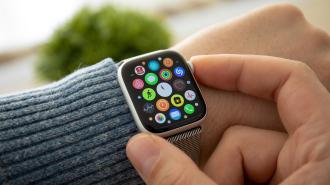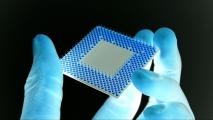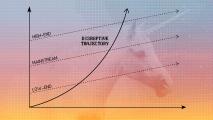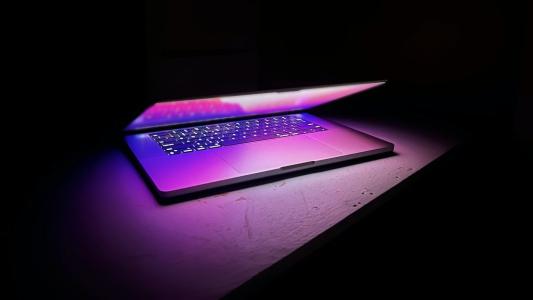Apple is developing technology to build noninvasive blood glucose monitoring right into its smartwatches, according to a report from Bloomberg — freeing people with diabetes (PWD) from painful needle pricks to test their blood sugar levels and potentially helping people with pre-diabetes avoid developing the disease.
The challenge: An estimated one in 10 Americans has diabetes. This means their bodies either don’t make insulin or can’t use it effectively to control the amount of glucose (a simple sugar) in their blood. Over time, chronically high blood sugar will damage the kidneys, heart, nerves, and eyes, leading to kidney and heart disease, as well as vision loss and even limb amputation.
People with diabetes can use diet and exercise to help keep their blood sugar in check, but it’s often necessary to regularly inject additional insulin to keep glucose at a safe level. For people with type 1 diabetes, in which the body doesn’t make insulin at all, daily insulin injections are imperative to survive.
Checking blood sugar levels causes anxiety for an estimated 30% of people with diabetes.
No matter what, it is crucial to regularly monitor blood sugar. PWD typically measure their glucose levels multiple times per day by pricking a finger with a needle to obtain a small blood sample for a tester.
That process is painful and causes anxiety for an estimated 30% of PWD, and that anxiety has been linked to testing avoidance, which can lead to chronically high glucose levels and serious health problems.
The idea: A continuous, pain-free way to monitor glucose levels could help more PWD effectively manage their diabetes, take insulin on time, and keep their blood sugar at safe levels.
We have seen promising research in the area of continuous noninvasive blood glucose monitoring, and even a few commercial devices that almost meet the brief — the sticker-like Dexcom G6, for example, will continuously monitor levels for up to 10 days, but it contains a small needle that can make applying a new sensor slightly painful.
No one has yet managed to bring a truly noninvasive, continuous monitor to market, though.
The tech is designed to determine glucose levels by measuring the reflection of laser light beamed into an area under the skin.
The scoop: Citing sources familiar with the matter, Bloomberg is now reporting that Apple is developing a device capable of noninvasive blood glucose monitoring — and in the long-term, it wants to build the tech right into the popular Apple Watch.
According to Bloomberg’s sources, the system is powered by two technologies — silicon photonics and optical absorption spectroscopy — and is designed to determine glucose levels by measuring the reflection of laser light beamed into an area under the skin.
Apple has reportedly trialed the tech with hundreds of people, and hundreds of engineers are now working on it at Apple’s Exploratory Design Group, which Bloomberg describes as similar to “X,” Google’s moonshot division.
The cold water: Apple has yet to officially confirm this information, and while the sources say the company trialed the tech under the name of a startup — Avolonte Health — it doesn’t appear that data from the trials is available publically, so we don’t know how well it performed.
“It has been investigated so many different ways, so many different times.”
John L. Smith
Apple isn’t the first group to attempt to monitor blood glucose using spectroscopy, either — and we’re still waiting for the approach to lead to a commercial product.
“To be quite candid, I don’t see anything that shows any greater promise than I saw 40 years ago, or 20 years ago, right now, in the optical measurement and spectroscopy areas,” John L. Smith, former CSO of Johnson & Johnson’s LifeScan division, which was focused on the development of blood glucose monitoring systems, told Optica in October 2022.
“It has been investigated so many different ways, so many different times,” added Johnson, who has published a book on the pursuit of noninvasive glucose monitoring tech.
Looking ahead: We have too little information to predict whether Apple will be successful where others have failed, but the company has reportedly already invested hundreds of millions of dollars into the project and doesn’t seem poised to give up the hunt any time soon.
Currently, the technology is in the proof-of-concept stage, according to Bloomberg’s sources, and Apple is now working on shrinking it down — the focus is on developing a prototype about the size of an iPhone that could be strapped to a person’s bicep.
Hundreds of engineers are reportedly now working on the tech at Apple’s Exploratory Design Group.
That doesn’t sound entirely comfortable, but the ultimate goal is to integrate the tech into the Apple Watch.
If blood glucose monitoring is as easy and painless as wearing a smartwatch, people at risk of developing type 2 diabetes — those with prediabetes or elevated blood sugar levels — might be more inclined to keep an eye on their levels. This could give them the opportunity to intervene early and avoid developing the disease in the first place.
Integrating glucose monitoring into smartwatches could even help people who are unaware of any issue with their blood sugar discover they have prediabetes — according to the CDC, 100 million American adults have the condition, but over 80% of them don’t know it.
We’d love to hear from you! If you have a comment about this article or if you have a tip for a future Freethink story, please email us at [email protected].





